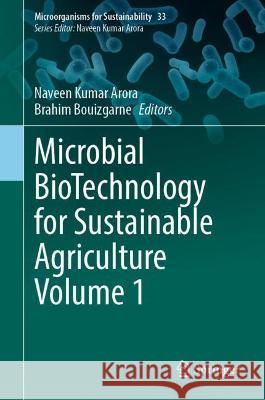Microbial Biotechnology for Sustainable Agriculture Volume 1 » książka



Microbial Biotechnology for Sustainable Agriculture Volume 1
ISBN-13: 9789811648427 / Angielski / Twarda / 2022 / 569 str.
Microbial Biotechnology for Sustainable Agriculture Volume 1
ISBN-13: 9789811648427 / Angielski / Twarda / 2022 / 569 str.
(netto: 690,08 VAT: 5%)
Najniższa cena z 30 dni: 693,97
ok. 22 dni roboczych
Dostawa w 2026 r.
Darmowa dostawa!
Prof (Dr) Naveen Kumar Arora, PhD in Microbiology, fellow of the International Society of Environmental Botanists (FISEB), Dean, School of Earth and Environmental Sciences, and Head Department of Environmental Science, Babasaheb Bhimrao Ambedkar University (A Central University), Lucknow, Uttar Pradesh, India, is a renowned researcher in the field of environmental microbiology and biotechnology. His specific area of research is plant–microbe interactions, sustainable agriculture and the environment. He has more than 100 research articles published in premium international journals and several articles published in magazines and dailies. Dr Arora is editor of 35 books, published by Springer Nature. He is the series editor of book series Microorganisms for Sustainability published by Springer Nature. Dr Arora is the Editor-in-Chief of the journal Environmental Sustainability, also published by Springer Nature. He is member of several national and international societies, editorial board member of four journals, and reviewer of several international journals. He has one patent to his name. Dr Arora has successfully completed six R&D projects sanctioned by funding agencies such as DST, DBT, CSIR, UPCST and UGC and at present has three ongoing projects funded by the Ministry of Science and Technology, New Delhi, India. He has delivered invited and keynote talks in conferences and seminars around the globe. Some of these include international conferences in USA, Portugal, China, Turkey, Morocco, Uzbekistan, Vietnam and Tashkent. Eleven scholars have been awarded PhD under his guidance. He has been awarded by national and international bodies and societies for research and academic work. Although an academician and researcher by profession, he is passionate about wildlife and its conservation and has authored a book on this subject entitledSplendid Wilds. Dr Arora is president of the Society for Conservation of Wildlife and secretary of the Society for Environmental Sustainability.
Brahim BOUIZGARNE obtained his PhD in 2005 at Cadi Ayyad University, Marrakesh, Morocco, in Microbial and Plant Biotechnology. He worked at Ibn Zohr University (Agadir, Morocco) as assistant professor in 2007. Currently, Brahim BOUIZGARNE is a full professor (Professor of Higher Education PES) in Microbial and Plant Biotechnology, and he is head of the research team Microbial Biotechnologies (Laboratory of Plant Biotechnology), at the Faculty of Sciences, Ibn Zohr University. His specific area of research is soil and agriculture microbiology, actinobacteria taxonomy, rhizosphere microbiology, plant-microbe interactions, phytopathology, plant growth-promoting rhizobacteria (PGPR), and biofertilizers and biopesticide development. Brahim Bouizgarne supervises 6 PhD candidates and has published 13 papers and 4 chapters with Springer. He is a reviewer of several international journals. He contributed to six research projects and supervises two research projects. He is also a member of the Moroccan Association of Biotechnology and Protection of Natural Resources “Microbiona.” He was the chair of the fourth edition of Microbiod 4 “Microbial Biotechnology for Sustainable Development,” Agadir, 2019, and served as a member of scientific committees of other conferences.
This volume explains the recent findings on the mutualistic plant–microbe interactions and how they can be utilized for sustainable agriculture practices including land reclamation. The book covers mainly plant growth promoting microorganisms (PGPMs) including both the symbiotic bacteria and fungi and their role in mobilization of nutrients, providing protection to the crops from phytopathogens and abiotic stresses.
PGPMs play important roles in survival and health of the plant. These useful microorganisms provide plants with nutrients, protect them from pathogens and help them combat abiotic stresses. It is important that these mutualistic interactions between plant and soil microbes are well understood so as to develop reliable products in the form of biostimulants and biopesticides, as well as managing biotic and abiotic stresses in crops. Apart from enhancing crop productivity plant–microbe interactions can also perform activities such as reclamation of degraded lands, degradation of pollutants and remediation of saline or marginal lands.
This book is of interest to teachers, researchers, plant scientists and microbiologists. Also, the book serves as additional reading material for undergraduate and graduate students of agriculture, microbiology, biotechnology, ecology, soil science and environmental sciences.
1997-2025 DolnySlask.com Agencja Internetowa
KrainaKsiazek.PL - Księgarnia Internetowa









